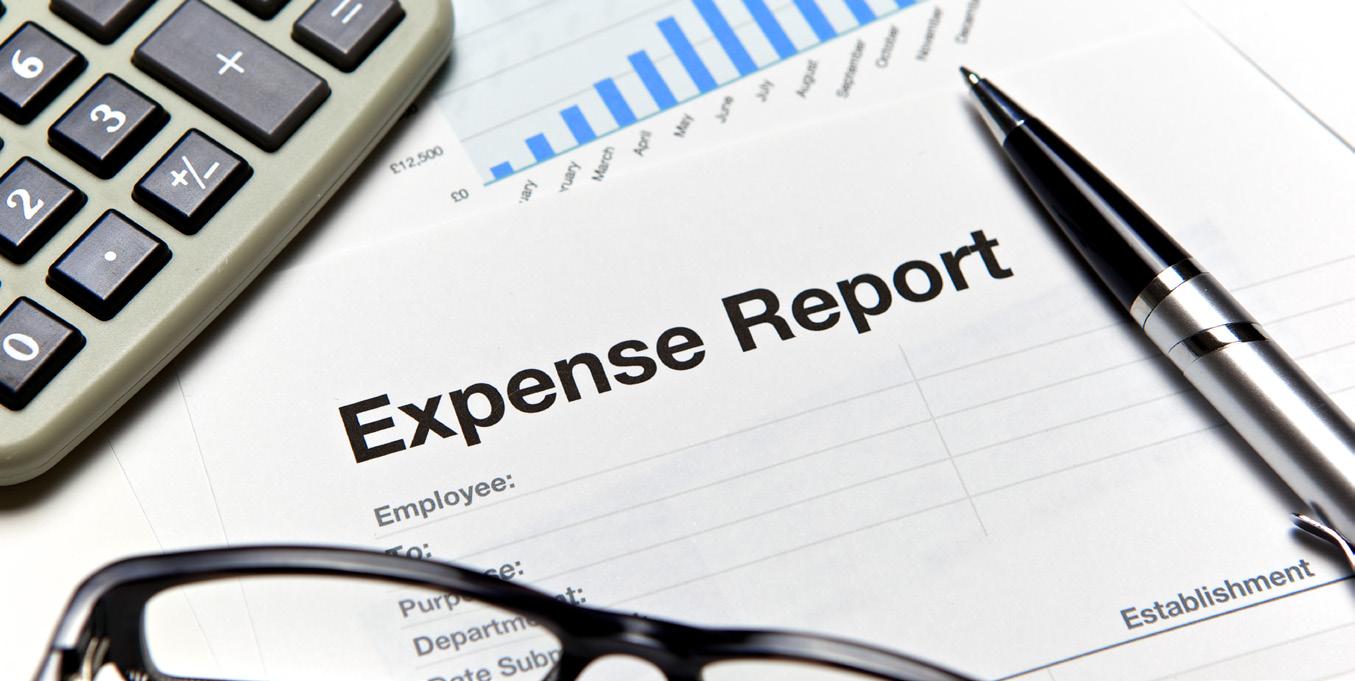
15 minute read
CPE Article: Common Errors on Form 990-PF
Common Errors on Form 990-PF
By Stephanie Morgan, CPA
CURRICULUM: Tax
LEVEL: Basic
DESIGNED FOR: Tax Practitioners
OBJECTIVES: To examine IRS guidance on Form 990-PF; identify common errors found when preparing the Form 990-PF and how to avoid them; and discuss the steep penalties imposed against private foundations and their managers
KEY TOPICS: Expense allocations and reporting in kind donations; failing to correctly report taxes paid; attaching a complete list of investments and fixed assets; incorrectly reporting capital gains and losses from investments; failing to determine eligibility for reduced tax rate; and not deducting the cost of furniture and fixtures as qualifying distributions
PREREQUISITES: None
ADVANCED PREPARATION: None
In recent years, scandalous news stories detailing the alleged misuse of public funds by certain former and sitting presidents and their family members has increased the general public’s awareness and the government’s scrutiny of private foundations.
Form 990-PF, Return of Private Foundation or Section 4947(a)(1) Nonexempt Charitable Trust Treated as a Private Foundation, is the annual informational return that must be filed by exempt private foundations, taxable private foundations and nonexempt charitable trusts treated as private foundations for tax purposes. The return is due by the 15th day of the 5th month following the end of the foundation’s tax year. The return of a foundation with a calendar year would be due on May 15th with the option of a six-month extension.
Penalties imposed on Form 990-PF are imposed not only on late or delinquent tax returns, but also on returns that are filed before the deadline that are inaccurate or incomplete. At first, that sounds easy enough to comply with, but filing an incomplete return can be as easy as failing to check a box when the foundation is not required to attach Schedule B.
Foundations with gross receipts up to $1,067,000 for the 2019 tax year will be assessed $20 per day that the return is considered late for a maximum penalty of $10,500 or 5% of gross receipts. Larger organizations whose gross receipts exceed $1,067,000 will be assessed $105 per day up to a maximum of $53,000 i .
If a Form 990-PF remains delinquent, the IRS may even impose a penalty against the person responsible for filing the return of $10 per day that the failure continues. If multiple people are responsible, they are jointly and severally liable, and total penalties against all individuals will not exceed $5,000.
In a section of the Form 990-PF instructions called “How to avoid filing an incomplete return,” the IRS provides the following guidance:
• Complete all applicable line items;
• Answer Yes, No or N/A to each question on the return;
• Make an entry (including a zero when appropriate) on all total lines;
• Enter None or N/A if an entire part doesn’t apply.
Common Errors
Since you don’t have to be a U.S. president to get into trouble serving on your family foundation’s board, let’s identify some of the more common errors found when preparing the Form 990-PF and discuss how to avoid them, along with the steep penalties imposed against private foundations and their managers.
ERROR: Expense Allocations and Reporting In-kind Donations in Part 1 Column (a)
Part 1 of Form 990-PF is the Analysis of Revenue and Expense. It can give the unwary preparer trouble as several common errors are found in this section of the return. Part I is essentially the foundation’s statement of financial activities allocated to various sources and purposes. Column (a) will generally include all the items of income and expense on the foundation’s books. The expenses in Column (a) must then be allocated to Column (b) through (d).
Column (b) will show the portions of revenue and expense items that are attributable to the foundation’s investment activity. Column (c) will most often be blank or N/A unless the organization is a private operating foundation. Lastly, column (d) reports the amount of the foundation’s expenses that are attributed to the foundation’s exempt purpose. Note that not all of the foundation’s expenses will qualify for reporting in any column other than (a) and the sum of column (b) through (d) may not equal the sum of Column (a). Expenses in Column (a) should be allocated only once. The same costs cannot be used to both reduce investment income and increase qualifying distributions.
In-kind revenue and expense accounts are commonly grouped together on financial statements and are fairly easy to identify and exclude from the tax return. Nonetheless, they are commonly reported incorrectly on Part 1.
One of many common errors found on Part I is when private foundations report the value of in-kind donations or pro-bono goods and services in column (a). The instructions are quite clear about these items, stating: “Don’t include the value of services donated to the foundation or items such as free use of equipment or facilitates in contributions received.”
Foundations can receive many kinds of in-kind donations, such as tangible goods (i.e., equipment, food or clothing) or intangibles like services and the use of property (free rent and advertising). It is important to remember that when in-kind income is eliminated, the corresponding expense must also be eliminated.
ERROR: Not Completing Part 1 Column (d) on Cash Basis
As noted, expenditures that are attributable to the foundation’s charitable purpose are allocated to column (d). The portion of each expense item reported in column (a) that is directly related to the foundation carrying out its exempt purpose will also be reported in column (d). Always complete line 25 in column (d), which includes contributions, gifts and grants, as these items inherently qualify as charitable expenses.
Other items commonly allocated to column (d) include legal fees for grant research and wages. Wages typically include the salary of the grant director or other officers of the foundation. However, since the CEO’s time is often split between management of the foundation’s investments and directly involved with the foundation’s charitable purpose, it is important to establish a reasonable and consistent method of allocating these costs between column (b) that reports the income and expense items related to the foundation’s investment income and column (d) charitable expenditures. The same costs should never be in both columns.
One method for an organization to document the basis for allocation is by using time logs to track the relative amount of time attributable to investment and charitable functions, then allocating a percentage of the total costs to each corresponding column.
Figure 1. Tax Reporting
Tax on Investment Income
18 - Taxes
Column (a) Only
Book Basis
Unrelated Business Income Tax
18 - Taxes
Column (a) Only
Book Basis
Payroll Taxes
15 - Contributions to employee pensions, plans and other benefits
Column (a) and (b) or (d), if applicable
Book Basis for Column (a) and (b), Cash Basis for Column (d)
All of the foundation’s expenses reported in column (d) are treated as distributions when calculating the 5% minimum distribution. Since distributions must be made by the end of the year, column (d) should be reported using the cash basis method of accounting regardless of the method used for book purposes by the client. ii
Therefore, it is necessary to make accrual to cash conversions for all expenditures reported in column (d). For example, the foundation should report the full amount of taxes accrued in column (a), but only the amount actually paid by year-end in column (d).
ERROR: Failing to Correctly Report Taxes Paid on Part 1, Lines 15 and 18
Private foundations are subject to a number of taxes that are reported in various places throughout the tax return and it’s important to report each tax correctly. Private foundations pay taxes on their investment income under section 4940 and their unrelated business taxable income under section 511. Both of these taxes should be reported on Page 1 line 18 Taxes in column (a) only. Since IRC 511 taxes are not costs associated with the management of the foundation’s investments, they do not belong in column (b). Since IRS 511 taxes paid are not expenditures necessary for the foundation’s charitable purpose, they would not be appropriate in column (d).
Private foundations are also subject to the same payroll taxes as for-profit employers. Preparers commonly report these expenses on line 18 with other taxes. However, the instructions for Form 990-PF Line 15, Contributions to employee pensions plans and other benefits, quite clearly state: “Also include the amount of federal, state and local payroll taxes for the year, but only include those that are imposed on the organization as an employer. This includes the employer’s share of Social Security and Medicare taxes, FUTA tax, State unemployment compensation tax, and other state and local payroll taxes.”
Payroll taxes would be reported in column (a) of Line 15 using the accounting method that matches the foundation’s books. As discussed previously, salaries and the related payroll taxes must be reasonably allocated to investment and charitable purposes. Amounts reported in column (b) relating to investments would also be reported using the accounting method of the foundation’s books. Column (d) charitable expenditures, however, must be reported on the cash method. See Figure 1, Tax Reporting.
ERROR: Not Attaching a Complete Listing of Investments and Fixed Assets, Part II
Investments. Another common error when preparing a private foundation’s tax return is the temptation to save time by not providing the level of detail requested in the instructions. An example of this is reporting all the foundation’s investments as a lump sum on line 13 Other Investments.
Investments are to be reported on Part II lines 10a through 10c and grouped into three categories consisting of domestic government obligations, corporate stocks and corporate bonds. Other portfolio investments are listed on line 13.
The instructions require that a schedule be attached to report each security, bond or other investment held at the end of the year with its cost basis or endof-year market value. Many private foundations have large investment portfolios consisting of dozens, if not hundreds, of individual positions, so this schedule can be quite time consuming. Resist the urge to aggregate and remember that omitting this detailed schedule results in an incomplete tax return.
One exception to this detailed reporting is debt securities of the U.S. government and state municipal obligations. These investments may be reported lump-sum, by type. If line 10a reported investments in U.S. and state government obligations consisting of both federal and state debt obligations, a schedule would need to be attached reporting the amounts relative to each type of investment.
Fixed Assets. Similar detailed reporting is required for many balance sheet accounts, including fixed assets. This includes a common error of not attaching a schedule to support the totals provided on line 11 Net Investment in Land, Building and Equipment. Here again, the instructions request a schedule listing each fixed asset held at the end of year, its original cost basis, accumulated depreciation and ending book value.
ERROR: Incorrectly Reporting Capital Gains and Losses From Investments, Part IV
There are two common errors when reporting capital gains and losses. The first is not providing the detailed transaction data stipulated in the instructions and the second is providing too much detailed transaction data.
The first error occurs when a tax preparer tries to save time by summarizing reportable gains and losses. The instructions to the form require very detailed reporting of each transaction that results in a capital gain or loss. Part IV requires a description of each investment sold; whether it was acquired by purchase or donation; date of acquisition and disposition; gross sales price; cost basis; and the gain or loss on the transaction. iii
The second error occurs when a tax preparer fails to take advantage of a time saving provision in the 990-PF Instructions, which allows the sales of publicly traded securities held inside a brokerage account to be reported in aggregate with the description “publicly traded securities.” iv It’s an important distinction to note that publicly traded securities not held in a brokerage account should not be aggregated.
Losses from the disposition of investments are subtracted from capital gains in arriving at investment income, but only to the extent of gains and only within the same tax year. Unique to non-profit tax reporting, the current year capital losses in excess of current year capital gains cannot be utilized to reduce overall investment income and are not carried forward to reduce future capital gains.
ERROR: Incorrectly Answering Part VII-B Question 1a (4)
Part VII-B, located on page 5 of Form 990-PF, addresses a number of questions with regards to acts of self-dealing between a foundation and disqualified persons, such as board members and substantial contributors. Selfdealing is when a foundation engages in certain types of transactions with disqualified persons. This can be an area of concern for private foundations because of the significant excise tax levied on such transactions. Section 4941 of the code imposes a tax on any disqualified person who engages in an act of self-dealing with a private foundation. The tax is 10% of the amount involved. v Moreover, an additional tax of 5% of the amount involved may be imposed on any foundation manager who participates in, or is knowingly complacent in, an act of self-dealing. vi

One of the more common errors found in Part VII-B is question 1a(4), which asks if the foundation has paid compensation to or reimbursed the expenses of a disqualified person. Commonly, this question is incorrectly answered “No.” While the code does provide an exclusion for compensation that is reasonable and necessary to carry out the exempt purpose of the foundation, the question should be answered “Yes” vii if these kinds of transactions were engaged in with any disqualified person, regardless of the amount.
Question 1b then asks if any of the acts of self-dealing fail to qualify under the exceptions described in the regulations. A foundation that reimburses its board members for reasonable expenses would answer question 1a(4) “Yes” and question 1b “No.” By doing so, the foundation is both properly disclosing their activity and not subject to the excise tax.
ERROR: Failing to Determine Eligibility for Reduced Tax Rate, Part VI
Section 4940 imposes a 2% tax on the net investment income of a private foundation. However, after its first year, a foundation may qualify to reduce this excise bill in half.
Part V of the return takes the preparer through a series of calculations to determine eligibility for the reduced tax rate. The first qualification is that the foundation must not have been subject to tax under section 4942 during any tax year included in the five-year base period.
Section 4942 is a tax imposed on private foundations that fail to distribute the minimum amount required by the code. The initial tax is equal to 30% of the undistributed income for the tax year. viii The tax increases to 100% for any amount that remains undistributed in the second tax year. ix For this purpose, undistributed income is defined as the amount by which the sum of the minimum investment return reduced by the amount of taxes imposed under section 4940 exceeds the qualifying distributions for the year. x This tax can always be avoided by ensuring that the foundation has distributed at least the minimum amount of funds necessary as calculated in Part XIII of the return.
The rest of Part V walks through the requirements described in Section 4940(e)(2):
If qualified distributions equal or exceed the sum of:
• The assets of the foundation multiplied by the average percentage payout for the base period, plus
• 1% of the net investment income
First, the preparer must calculate the average distribution ratio for the base period by dividing the adjusted qualifying distributions by the net value of the non-charitable use assets of the foundation for each of the five proceeding tax years. These amounts can be found on the Form 990-PF of each year within the base period in Part X Line 5 and Part XII Line 6, respectively
The average of those ratios is then multiplied by the current year’s non-charitable-use assets. If that result plus 1% of the foundation’s net investment income as calculated on page one of the Form 990-PF is equal to or greater than the current year’s qualifying distributions as determined in Part XII, then the organization will qualify for the reduced rate.
For this reason, it’s incredibly important to accurately calculate the organization’s qualifying distributions and that means properly allocating costs to column (d) as discussed previously and avoiding the next common error of not deducting the cost of furniture and fixtures as qualifying distributions in Part XII.
ERROR: Not Deducting the Cost of Furniture and Fixtures as Qualifying Distributions in Part XII
If furniture, fixtures and equipment recorded on the balance sheet are charitable use assets, they can be included on line 2 of Part XII in calculating qualifying distributions, thus essentially allowing the foundation to expense the entire cost in the year of acquisition.
A planning tip for anyone working with nonprofit organizations would be to distinguish the foundation’s charitable use assets from other fixed asset accounts on the balance sheet when setting up the chart of accounts. At minimum, a separate ledger of these expenditures should be maintained in order to take advantage of this tax-saving provision.
Proper Filing of the Form 990-PF
The instructions provided by the IRS are the best tool to insure proper filing of the Form 990-PF. They provide very thorough directions on how to complete each section of the return and should be referenced by preparers navigating the reporting requirements of a private foundation.
Tax preparers working with nonprofit organizations should consider reviewing the chart of accounts and general ledger well before the 990-PF is due to identify areas where the presentation of financial data can be improved. This will in turn improve the ability of the preparer to efficiently retrieve tax information and decrease time spent on return preparation.
ENDNOTES
i 2019 Instructions for Form 990-PF (DRAFT) ii 2018 Form 990-PF Instructions, Page 15 iii 2018 Instructions for Form 990-PF, Page 22 iv 2018 Instructions for Form 990-PF, Page 22 v 4941(a)(1) vi 4941(a)(2) vii 4941(d(2)(E) viii 4942(a) ix 4942(b) x 4942(c)
About the Author: Stephanie Morgan is a CPA in public practice at Gollob Morgan Peddy, PC and can be reached at stephaniem@gmpcpa.com.










